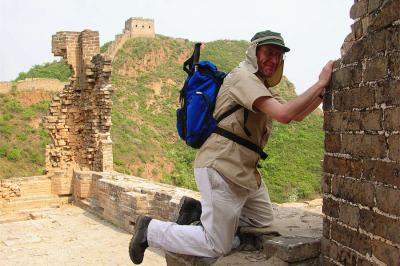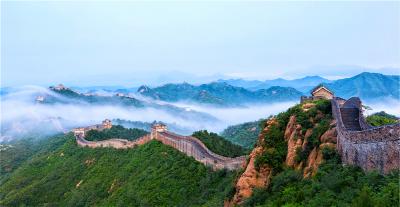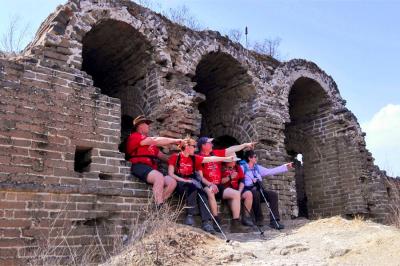40 Important Facts About The Great Wall Of China
It's one of the most famous man-made architecture of all time, but what do you actually know about the Great Wall of China? How old and how long is the Great Wall of China? Why and when was it built? And, why is it so important in Chinese history and culture? It is time to dive in our 30 amazing facts of the Great Wall of China.
Top 10 Facts about the Great Wall of China
1. The length of the Great Wall of China: 21196.18 kilometers (about 13171 miles), which makes it the longest man-made structure in the world.
2. In China, the Great Wall of China is called “wan-li-chang-cheng” (万里长城), literally meaning 10,000-li long wall, Li a traditional Chinese unit of distance, now 1 kilometer = 2 li. Or we simply use “Chang Cheng” (long wall, 长城) to address the Great Wall in Chinese language.
4. The Great Wall of China is an amazing military defense project in the ancient world. It is not a simple, narrow city wall, but a complete defense system, included the passes, beacon tower, military forts, moats (at certain parts), etc.

5. When thinking of the first builder of the Great Wall, people think about Qin Shi Huang, which is actually wrong! Before 656 B.C., the vassal state of Chu built a wall called “Fangcheng (Literally Square Wall)” on the border of Qi and Chu to defend itself against Qi's attack, which was the first Great Wall of China.
6. The history of the Great Wall can be traced back to the Western Zhou Dynasty and has been built over two thousand years by more than twenty dynasties. Among them, the Great Wall of the Qin, Han and Ming dynasties is the most famous.
7. The builders of the Great Wall included soldiers of the border garrison, peasants, prisoners, craftsmen and technicians, prisoners of war, and local officials and families. During the Qin, Han and Ming dynasties, a large number of border guards were involved in the construction, both as builders and defenders.
8. The extant Great Wall resources are mainly distributed in 15 provinces, autonomous regions and municipalities including Hebei, Beijing, Tianjin, Shanxi, Shaanxi, Gansu, Inner Mongolia, Heilongjiang, Jilin, Liaoning, Shandong, Henan, Qinghai, Ningxia and Xinjiang. Among them, Hebei Province has the longest wall with a distance of 2,000 kilometers, and the length of the wall in Shaanxi Province is 1,838-kilometer-long.
9. On April 18, 2009, it was announced that the Ming Great Wall (currently the best preserved walls) started from Hushan in Liaoning in the east and Jiayuguan in Gansu in the west, covering 156 counties in 10 provinces, autonomous regions and municipalities. The total length is 8851.8 kilometers long.
10. Both the Great Wall and Chinese dragon are the symbols of China. As they have similar shapes, nowadays many Chinese people consider the Great Wall just like a huge dragon entrenching itself on the land of the country as a guardian angel.
The Most Important Great Wall of China Facts about Its History
11. The constructions of the defensive walls started from West Zhou Dynasty (1046-771 BC). Now what we can find the earliest extant wall is the one built in the Spring and Autumn Period (770-476 BC) by Qi State. The word of “Chang-Cheng” (长城, the Great Wall) first came from the famous book Records of the Historian (史记). It mentions: "King Xuan of Qi State built “Chang-Cheng” (the Great Wall) on the mountains, connecting the sea to the east and Jizhou to the west, a total of more than 1,000 li (500 km), in order to guard against the army of Chu State."
12. There are many famous emperors and generals in history who built the Great Wall of China. In 221 B.C., Emperor Qin Shi Huang annihilated the six kingdoms and united China, connecting the Great Walls of Qin, Yan and Zhao together to form a powerful military defence system. After ascending to the throne, Emperor Wu of Han Dynasty repaired the Qin Great Wall and built the Outer Great Wall, which was nearly 10,000 kilometres long, starting from the city of Ershi in Dawan in the west and ending at the north bank of the Yalu River in the east. In the Ming Dynasty, the construction of the Great Wall began with Emperor Zhu Yuanzhang, the founder of the Ming Dynasty, and continued for more than two hundred and seventy years. Qi Jiguang and Tan Lun were responsible for the defence of the Great Wall and supervised the construction of the Great Wall.
13. From the Qin Dynasty (秦朝) to the Qing Dynasty (清朝), many passes/gates along the Great Wall became the marketplaces for the barter trade between the agricultural and nomadic civilizations. Some trading ports came into being along the Great Wall. Therefore, the Great Wall not only played the role of separation and protection, but also shouldered an important task of closely linking the two economies and cultures.
14. During the Qing Dynasty, the Great Wall gradually weakened as a military defence and was used more as a tool for surveillance and border management.

15. It was in 1944 that the Great Wall of China witnessed the last battles in Laiyuan County of Hebei Province, which was during the Sino-Japanese War (World War II). The battles happened at Chajianling (插箭岭) Great Wall between the Communist Eighth Route Army and Japanese Imperial Army. Even today we can still see the bullet marks on some walls.
Constructions, Workers, and Builders
16. There are a total of 13 strategic passes along the Great Wall. They are Shanhaiguan (山海关), Huangyaguan (黄崖关), Juyongguan (居庸关), Zijingguan(紫荆关), Daomaguan (倒马关), Pingxingguan (平型关), Piantouguan (偏头关), Yanmenguan (雁门关), Niangziguan (娘子关), Shahukouguan (杀虎口关), Jiayuguan (嘉峪关), Yangguan (阳关), Yumenguan (玉门关).17. The average height of the Great Wall is 7.8 meters with an average width of 6.5 meters at the base, and some sections are as high as 14 meters. On the steep mountains, the structures are relatively lower, while in those flatlands they are higher. And at the crucial spots, the walls were built taller, with low height for the ordinary sections.
18. During the Qin and Han Dynasties, nearly tens of millions of soldiers and civilians were dispatched for the construction of the Great Wall of China. During the reign of Qin Shihuang, he accepted the suggestion from his advisors and moved thousands of soldiers and civilians to the border areas for the building and maintenance of the Great Wall. In the following Han Dynasty, more people were relocated to the border to guard the territory. On the other hand, this practice only accelerated the economic development of the remote areas, saved a lot of government military expenditure, but also greatly reduced the suffering of long-distance transportation, and spread Chinese culture further away.
19. In order to make the Great Wall more stable, a secret formula was applied to prepare the mortar. The construction workers mixed sticky rice soup with slaked lime to make a composite mortar that had more strength and water resistance than lime mortar. During the Ming dynasty (1368–1644 AD), brick-making techniques improved significantly in terms of quantity and quality of production. Since then, Great Wall sections were widely built with bricks, with lime mortar and sticky rice used to reinforce the bricks strongly enough to resist earthquakes and floods while keeping the building intact.
20. Considering the building materials of the Great Wall of China, it can be divided into three types: rammed earth wall, sliced stone wall and brick wall. As the Great Wall stretches so extensively in North China, the builders had to rely upon the local materials. In the arid Gobi Desert, the wall was built with the willow reeds (twigs), gravels and sandy soil. In the loess and plain areas, the rammed earth wall was more widely applied, while in the mountainous area near Beijing, we can often see the wall constructed with fired bricks and granite slabs.
21. When seeing the man-made feat, many travelers may be curious how the ancient people built it with bricks and stone slabs coming from afar. According to the historical records, when people built the wall at Jiayuguan Pass, they used the goats to carry the bricks up to the wall top. At that time, without machinery, it was very hard to move the stone slabs to the construction site from the quarry miles away. During the winter, the workers built a basic road between the two spots, and pour a lot of water on it, which soon was turned into an icy trail, so that the builders could transport the stones to the pass much more easily.
22. There are about 7000 beacons (beacon towers) along the Great Wall as an ancient information transmission system, which is the oldest but effective method of information transmission. The average distance between two beacon towers is 5 kilometers, but in some sections, the distance is only 2,500 meters. It was invented by the people in Han Dynasty more than 2000 years ago. Columns of smoke were used to warn defenders of an attack. One smoke column meant an outpost was being threatened by a force of fewer than 500 troops; two columns meant an attacking force of fewer than 3,000, and so on. The ancient Han people found the beacon system relayed messages faster than a rider on a horse.
23. At the intersection of the Great Wall and a river, there are often arched water gates with double holes. The design is also known as the "Water Gate". There is a sluice device on the water gate, which can control the amount of water going through the gate during the wet and dry seasons. The famous water passes include Jiumenkou Great Wall (Liaoning), Badaling Shuiguan Great Wall (Beijing), the water gate of Huangyaguan Great Wall (Tianjin), and so on.
24. The Great Wall has a very "intelligent" drainage system. Its main buildings like the fort or (beacon) tower were built with drainage facilities such as drainage ditches, water retaining bricks, drainage holes, etc., which can discharge accumulated water in time. In this way, various sections of the Great Wall have withstood the test of continuous erosion by rainwater for a long time.
Keep reading about the Great Wall of China facts:
Fun Facts about the Great Wall of China
25. There are 3 sections of the Great Wall in water: Laolongtou Great Wall (Qinhuangdao, Heibei Province), Xifengkou Great Wall (Qianxi County, Hebei Province) and Huanghuacheng Great Wall (Beijing). The former one was intentionally extended to the sea as part of the defense system, while the latter two were caused by the construction of modern reservoirs, which raised the water level and submerged small sections of the Great Wall. Travelers can even try diving to see the underwater Great Wall at Xifengkou (Panjiakou Reservior), Hebei Province.

26. The most famous legend about the Great Wall of China is the story of Lady Meng Jiang (Meng Jiang Nü, 孟姜女), the wife of Fan Xi-liang, who was forced to work as a builder of the wall during the Qin Dynasty. After waiting for a long time without meeting her husband, Lady Meng Jiang decided to carry her hand-made cotton padded coat to his construction site. When she found out her husband had died during the work, she wept day and night until a section of the wall near her collapsed, exposing the dead body of her husband from the rubbles. So that she could bury him in a tomb. After that, she also committed suicide by throwing herself into the sea.
27. Surprise! According to historical documents and archaeological findings, some of the building materials of the Great Wall contain glutinous rice. Glutinous rice paste, when mixed with lime, was used to strengthen the bond between bricks, thereby increasing the durability of the building. This natural “cement” helped to protect the Wall from the natural environment and war damage.
28. One interesting fact about the Great Wall of China you probably didn’t know - it has a variety of colours, depending on the region, climate and materials used. For example, the Ming Dynasty Great Wall made of brick in Hebei and Beijing is mostly grey-brown. In the northwestern desert area, the Wall is mostly made of compacted loess, which is yellow in colour. Some of the better-preserved stone wall segments are light green to dark green due to weathering and moss coverage over the millennia.
Today’s Great Wall of China
30. Nowadays, the Great Wall we often see in North China was mostly built in the Ming Dynasty (1368-1644), especially those stone-and-brick walls in Beijing and Hebei Province. They predominantly have a history of 600-700 years.
31. The most visited section of the wall is known as Badaling Great Wall, located in Yanqing District, Beijing. There are more than 10 million visitors here annually. While Mutianyu Great Wall is more recommended to international travelers as it is less crowded, if you plan to a Great Wall of China tour from Beijing. And there are more options, for example, between Jinshanling and Simaitai, there is a hiking trail for the intrepid travelers.
33. According to the experts’ estimates, 1/3 of the Great Wall might have disappeared. Many parts of the walls have been thoroughly destroyed. On October 11, 2006, the "Great Wall Protection Regulations" were enacted and implemented. After the promulgation of the "Great Wall Protection Regulations", many places began to pay attention to and protect the Great Wall. However, the damage to the Great Wall was still serious, especially in the central and western provinces of Gansu, Ningxia, Shaanxi and Shanxi due to human and natural factors combined.
34. A study has shown that the Great Wall is protected by a “biological cover” of mosses, lichens and cyanobacteria. Rather than gradually destroying the masonry, as previously thought, these plants provide protection from the elements. They cover the surface of the Wall, forming a “‘living skin” that reduces the intrusion of water into the wall, thus slowing down the rate of damage and having a positive impact on maintaining the Wall's structural integrity.
Explore Best Great Wall of China Tours:
More Unknown and Cool facts of the Great Wall of China
35. Gunpowder is one of China's Four Great inventions. Archaeologists have discovered about 60 simple ancient grenades along the Great Wall, dating back to the Ming Dynasty. The weapon is rumoured to have been popularised by Qi Jiguang, a Ming military general, and had a huge impact on Chinese military strategy at the time.
36. On second line of the lyrics of the China’s national anthem: “Arise! All those who don’t want to be slaves! Forge the new Great Wall with our blood and flesh!" The word “Great Wall” is mentioned in it, expressing the common aspirations and sentiments of Chinese people.
37. Over 520 world leaders and VIPs have already visited the Great Wall of China. In 1954, Jawaharlal Nehru, then Prime Minister of India, was the first foreign political leader, who visited the Great Wall. US president Richard Nixon and his wife set foot on Badaling Great Wall during their historical visit in 1972. It is less known outside China that due to a sudden heavy snow storm, 800,000 people were mobilized on Feb. 23, 1972 to clear the snow manually overnight on the way to the Great Wall to guarantee the safety of the US president.38. In 1971, after gaining the restoration of the lawful rights of PRC in the UN, Chinese government presented a gift to the United Nations General Assembly, which was a large tapestry of the Great Wall. This shows that the Chinese people and the government have regarded the Great Wall as a symbol of the Chinese nation.
39. In Dec, 1987, the Great Wall of China was inscribed on the UNESCO World Heritage list. It is also considered to be one of the Seven Wonders of the Medieval World.
40. Archaeologists and restoration specialists use modern technology, such as satellite positioning and geographic information systems, to re-map and study these ‘lost’ Wall, providing opportunities for possible future restoration.